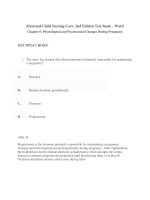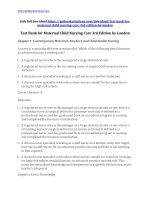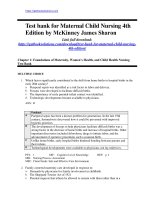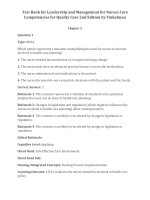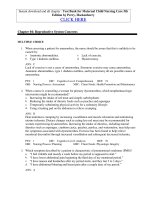Download PDF maternal child nursing care 2nd edition test bank ward
Bạn đang xem bản rút gọn của tài liệu. Xem và tải ngay bản đầy đủ của tài liệu tại đây (669.72 KB, 44 trang )
Maternal-Child Nursing Care: 2nd Edition Test Bank – Ward
Chapter 8: Physiological and Psychosocial Changes During Pregnancy
MULTIPLE CHOICE
1. The nurse has learned that which hormone is primarily responsible for maintaining
a pregnancy?
A.
Estrogen
B.
Human chorionic gonadotropin
C.
Oxytocin
D.
Progesterone
ANS: D
Progesterone is the hormone primarily responsible for maintaining a pregnancy.
Estrogen promotes hyperplasia and hypertrophy during pregnancy. After implantation,
the trophoblast secretes human chorionic gonadotropin, which prompts the corpus
luteum to continue progesterone production until the placenta takes over the job.
Oxytocin stimulates uterine contractions during labor.
Cognitive Level: Knowledge/Remembering
Content Area: Pediatrics/Maternity
Patient Needs: Physiological Integrity: Physiological Adaptation
Integrated Process: Teaching/Learning
Difficulty: Easy
PTS: 1
2. A patient who is 28 weeks pregnant calls the obstetrical clinic and complains of
irregular, painless contractions that last for 10 to 15 seconds. What response by
the nurse is best?
A.
“If they last more than 60 seconds or become regular,
come in.”
B.
“Oh, you are just having what are called Braxton
Hicks contractions.”
C.
“Pregnant women often experience this type of
contraction.”
D.
“You should come in to the clinic as soon as
possible today.”
ANS: A
Braxton Hicks contractions are irregular and painless and last less than 60 seconds.
Their function is to prepare the uterine muscles for effective labor. If they become
regular or last longer than 60 seconds, the woman needs medical attention. The other
statements all contain some truthful information, but none provides the woman with the
knowledge she needs to remain healthy.
Cognitive Level: Comprehension/Understanding
Content Area: Pediatrics/Maternity
Patient Needs: Physiological Integrity: Physiological Adaptation
Integrated Process: Teaching/Learning
Difficulty: Easy
PTS: 1
3. The nurse caring for perinatal patients understands the term decidua to mean
which of the following?
A.
Collateral uterine circulation
B.
Endometrial lining of the uterus
C.
Endometrial tissue covering the embryo
D.
Placental remnants left in the uterus
ANS: B
The decidua is the endometrium lining the uterus and consists of three layers. The
decidua capsularis is the endometrial tissue that covers the embryo. Decidua does not
refer to collateral circulation or placental remains.
Cognitive Level: Knowledge/Remembering
Content Area: Pediatrics/Maternity
Patient Needs: Health Promotion and Maintenance
Integrated Process: Nursing Process: Assessment
Difficulty: Easy
PTS: 1
4. A nurse is assessing a patient in the women’s clinic for Chadwick’s sign. How
does the nurse perform this assessment?
A.
Auscultates the woman’s abdomen for fetal heart tones
B.
Inspects the vulva and vagina for a bluish tint
C.
Palpates the woman’s abdomen for a fluid wave
D.
Percusses the woman’s abdomen for uterine margins
ANS: B
Chadwick’s sign is one of the earliest signs of pregnancy and consists of a bluish
discoloration of the cervix, vulva, and vagina. The nurse would inspect the woman
for this discoloration.
Cognitive Level: Application/Applying
Content Area: Pediatrics/Maternity
Patient Needs: Health Promotion and Maintenance
Integrated Process: Nursing Process: Assessment
Difficulty: Moderate
PTS: 1
5. An instructor is explaining to students in the OB rotation that Goodell’s sign is
which of the following?
A.
Bluish cervical discoloration
B.
Cervical softening
C.
False labor contractions
D.
Slowed fetal heart tones
ANS: B
Goodell’s sign is softening of the cervix that occurs due to hormonal influences. It is not
related to fetal heart tones or contractions. Chadwick’s sign is a bluish discoloration of
the cervix, vulva, and vagina.
Cognitive Level: Comprehension/Understanding
Content Area: Pediatrics/Maternity
Patient Needs: Health Promotion and Maintenance
Integrated Process: Nursing Process: Assessment
Difficulty: Moderate
PTS: 1
6. A nurse is teaching a woman who is in her first trimester of pregnancy about
physical changes she can expect. Which information should the nurse provide?
A.
Diminishing sexual interest occurs.
B.
Harmful agents are able to invade the uterus.
C.
Leukorrhea is an abnormal condition.
D.
Pregnant women are more susceptible to yeast infections.
ANS: D
Glycogen levels are increased in vaginal cells during pregnancy, and this change creates
an environment more hospitable to Candida albicans. Thus pregnant women are more
susceptible to yeast infections. For some women, the increased pelvic congestion leads to
increased sexual interest and orgasmic ability. Harmful agents are kept out of the uterus
by the mucus plug. Leukorrhea is a normal finding in pregnancy due to hyperplasia of
the vaginal mucosa and increased mucus production from the endocervical glands.
Cognitive Level: Application/Applying
Content Area: Pediatrics/Maternity
Patient Needs: Health Promotion and Maintenance
Integrated Process: Teaching/Learning
Difficulty: Moderate
PTS: 1
7. A woman who gave birth 2 months ago calls the perinatal clinic crying
because her hair is falling out in large amounts. What action by the nurse is
most appropriate?
A.
Advise the woman to make an appointment with
a dermatologist.
B.
Explain that this symptom will end once she stops
breastfeeding.
C.
Reassure the woman that her hair will grow back
within a year.
Tell the woman it’s really extra hair that grew
in pregnancy.
D.
ANS: C
New hair growth may be stimulated during pregnancy, but after birth, this process
reverses and hair shedding occurs for 1–4 months. Virtually all hair will be replaced
within 6–12 months. The nurse should educate the woman about this natural
process. Although telling the woman that she had extra hair in pregnancy is
accurate, simply stating this fact does nothing to ease her distress. The woman does
not need to see a dermatologist. The process is not related to breastfeeding.
Cognitive Level: Application/Applying
Content Area: Pediatrics/Maternity
Patient Needs: Health Promotion and Maintenance
Integrated Process: Nursing Process: Implementation
Difficulty: Moderate
PTS: 1
8. A pregnant woman in the perinatal clinic complains of a diffuse, reddish
discoloration of her palms. What action by the nurse is most appropriate?
A.
Ask if she has been exposed to measles.
B.
Assess her for Reynaud’s phenomenon.
C.
Explain that this is a normal finding.
D.
Take the woman’s vital signs.
ANS: C
Palmar erythema is a reddish discoloration of the palms and occurs in about 60% of
Caucasian women and in about 35% of African American women during pregnancy.
Although the nurse should assess the patient’s vital signs during the visit, there is no
need to do so specifically tied to this condition. Palmar erythema is not related to measles
or Reynaud’s phenomenon, which is a vascular condition.
Cognitive Level: Application/Applying
Content Area: Pediatrics/Maternity
Patient Needs: Health Promotion and Maintenance
Integrated Process: Nursing Process: Implementation
Difficulty: Moderate
PTS: 1
9. A woman in her third trimester of pregnancy complains of a painful burning
sensation in her hands and lower arms. Which action by the nurse is best?
A.
Advise the woman to elevate her hands at night.
B.
Document the finding and alert the provider.
C.
Encourage the woman to see a neurologist.
D.
Request a prescription for pregabalin (Lyrica).
ANS: A
Edema that occurs during pregnancy can lead to fluid collection in the wrist and puts
pressure on the median nerve. This leads to carpal tunnel syndrome, characterized by
burning pain and paresthesia in the (usually dominant) hand or hands up to the elbow.
The nurse should advise the woman to elevate her hands at night. Carpal tunnel
syndrome usually resolves after pregnancy, but if it persists, the woman may require
surgical treatment. The nurse should always document abnormal findings and alert the
provider, but further action is needed. Lyrica is used for nerve pain and would not be
suggested here.
Cognitive Level: Application/Applying
Content Area: Pediatrics/Maternity
Patient Needs: Health Promotion and Maintenance
Integrated Process: Nursing Process: Implementation
Difficulty: Moderate
PTS: 1
10. A pregnant woman in the perinatal clinic complains of occasional fainting. Which
action by the nurse is best?
A.
Educate her that this is a frequent occurrence in
pregnancy.
B.
Encourage her to carry small snacks with her at all times.
C.
Instruct her to lie down when the warning signs occur.
D.
Tell her to lie down on her left side if she has warning
signs.
ANS: D
Syncope, or fainting, is occasionally seen in pregnancy and is often preceded by warning
signs such as lightheadedness, sweating, nausea, yawning, or sensations of warmth. The
nurse should instruct the woman to sit or lie down when these warning signs occur.
Lying on the left side is preferred to avoid compressing the vena cava. Simply saying that
this occurs frequently does not help the woman take care of herself. This symptom is not
related to food intake.
Cognitive Level: Application/Applying
Content Area: Pediatrics/Maternity
Patient Needs: Health Promotion and Maintenance
Integrated Process: Teaching/Learning
Difficulty: Moderate
PTS: 1
11. A woman in the emergency department is in her third trimester and is bleeding
heavily from a laceration on her thigh from a car crash. She is pale and
diaphoretic. Her blood pressure is 138/82 mm Hg. What can the nurse
conclude from this information?
A.
Blood loss from the laceration has not been that great.
B.
She is in shock from the trauma of the injury and blood
loss.
C.
Her increased blood volume is maintaining the
blood pressure.
D.
Her vital signs and physical assessment do not match.
ANS: C
Maternal blood volume increases by 40 to 50% near term. The nurse would expect the
blood pressure to be low due to the blood loss, but the pregnancy-related extra volume
is maintaining the blood pressure at normal levels. The vital signs and physical
assessment do not match, but that is vague and does not explain the inconsistency. The
patient is not in shock.
Cognitive Level: Analysis/Analyzing
Content Area: Pediatrics/Maternity
Patient Needs: Nursing Process: Analysis
Integrated Process: Physiological Integrity: Physiological Adaptation
Difficulty: Difficult
PTS: 1
12. A woman in the third trimester of her first pregnancy complains of excessive
fatigue. Her hemoglobin is 11.2 g/dL. What action by the nurse is best?
A.
Arrange hospital admission for blood transfusions.
B.
Assess the woman’s diet for adequate iron and protein.
C.
Inform the woman that this is a normal finding in
pregnancy.
D.
Tell the woman to get more sleep at night and to take
naps.
ANS: B
Anemia of pregnancy occurs mainly due to hemodilution. The mean acceptable
hemoglobin level in pregnancy is 11–12 g/dL. Some women experience fatigue due to
this change. Sleep disturbances can contribute to the fatigue, but the nurse should ensure
that the woman is adequately hydrated and is eating a diet high in protein and iron. She
does not need transfusions. Informing the woman that this is normal does not give her the
information she needs to care for herself. If sleep disturbances are a contributing
factor, extra sleep can help.
Cognitive Level: Application/Applying
Content Area: Pediatrics/Maternity
Patient Needs: Health Promotion and Maintenance
Integrated Process: Nursing Process: Assessment
Difficulty: Moderate
PTS: 1
13. A woman in her second trimester of pregnancy is in the clinic for a checkup. She
complains of feeling short of breath at times. Her lungs are clear and her oxygen
saturation is 98%. Her vital signs are all normal. What action by the nurse is best?
A.
Alert the provider to the symptoms.
B.
Encourage slow, deep breathing.
C.
Document the findings.
D.
Facilitate a chest x-ray.
ANS: B
Many pregnant women verbalize an increased awareness of the need to breathe and can
perceive this as dyspnea. Because there are no other abnormalities, the nurse should
reassure the woman that this is normal and encourage slow, deep breathing while
resting with the head elevated.
Cognitive Level: Application/Applying
Content Area: Pediatrics/Maternity
Patient Needs: Health Promotion and Maintenance
Integrated Process: Teaching/Learning
Difficulty: Moderate
PTS: 1
14. The perinatal nurse reads the diagnosis of ptyalism in a patient’s chart. What
teaching does the nurse plan for this patient?
A.
Chew food thoroughly before swallowing.
B.
Drink plenty of decaffeinated beverages.
C.
Eat something before getting up in the morning.
D.
Lozenges and chewing gum can help.
ANS: D
Ptyalism is excessive production of saliva. The etiology is uncertain, but chewing
gum and using lozenges can offer limited relief. The other measures are not helpful
for this condition.
Cognitive Level: Application/Applying
Content Area: Pediatrics/Maternity
Patient Needs: Health Promotion and Maintenance
Integrated Process: Teaching/Learning
Difficulty: Difficult
PTS: 1
15. A pregnant woman is complaining of frequent heartburn. What statement by
the patient indicates to the nurse that teaching has been effective?
A.
“Drinking less alcohol should prevent this.”
B.
“Eating larger, less frequent meals will help.”
C.
“I should take antacids before each meal.”
D.
“I will not lie down for 1 hour after eating.”
ANS: D
Heartburn, or pyrosis, occurs due to changes in the function of the cardiac sphincter, which
allows reflux of stomach contents into the esophagus. Self-care measures for this condition
include eating small meals and remaining upright for at least an hour after meals. Antacid
use should be limited. Pregnant women should not drink alcohol at all.
Cognitive Level: Evaluation/Evaluating
Content Area: Pediatrics/Maternity
Patient Needs: Health Promotion and Maintenance
Integrated Process: Teaching/Learning
Difficulty: Moderate
PTS: 1
16. A student asks the nurse why so many pregnant women get cholecystitis. Which
response by the nurse is best?
A.
“Inefficient emptying leads to stasis of bile and
inflammation, or cholecystitis.”
B.
“Pregnant women crave high-fat foods that
cause gallbladder irritation.”
C.
“Some pregnant women have a genetic predisposition to
gallbladder problems.”
D.
“Vascular changes to the liver capsule cause bile to back
up into the gallbladder.”
ANS: A
The gallbladder muscle becomes more relaxed during pregnancy, resulting in inefficient
emptying. Stasis of the bile occurs, which then leads to infection or inflammation
(cholecystitis). High-fat meals can worsen the symptoms, which include epigastric pain.
However, this is not the primary etiology. This condition is not related to genetic
predisposition and liver vascular changes.
Cognitive Level: Comprehension/Understanding
Content Area: Pediatrics/Maternity
Patient Needs: Physiological Integrity: Physiological Adaptation
Integrated Process: Teaching/Learning
Difficulty: Moderate
PTS: 1
17. What information should the nurse plan to teach a pregnant woman
regarding safety in the third trimester?
A.
Don’t drive after dark.
B.
Exercise to maintain good posture.
C.
Use handrails when using the stairs.
D.
Wear supportive shoes.
ANS: C
Pregnant women experience laxity of the ligaments, separation of the pubis symphysis,
and changes in their center of gravity, which places them at risk for falling. The most
immediate action the woman can take is to use caution when negotiating stairs. Exercise
can help with toning abdominal muscles and can reduce some of the symptoms of these
changes, but results take time. Wearing supportive shoes and avoiding driving after dark
are not related.
Cognitive Level: Application/Applying
Content Area: Pediatrics/Maternity
Patient Needs: Health Promotion and Maintenance
Integrated Process: Teaching/Learning
Difficulty: Easy
PTS: 1
18. A pregnant woman calls the clinic to complain of sharp, right-sided lower
abdominal pain. Which question by the nurse would elicit the most
relevant information?
A.
“Do you have a fever, constipation, or any diarrhea?”
B.
“Have you fallen down or experienced any kind of injury
in the last few days?”
C.
“Have you tried placing either a heating pad or an ice
pack on your abdomen?”
D.
“Is the pain worse between your navel and hip bone or
closer to the hip?”
ANS: A
Sharp pain in the lower abdomen is frequently due to round ligament pain. However,
more serious conditions need to be ruled out first. Appendicitis must be considered.
Because the appendix is pushed up and posterior by the uterus, the typical location of
pain on the right side between the umbilicus and anterior iliac crest (McBurney’s point) is
not accurate. The nurse should ask about fever or changes in bowel habits. Trauma is not
as likely a cause of this pain. After ruling out a serious medical condition, the nurse can
advise the patient to use heat to help relieve the pain.
Cognitive Level: Application/Applying
Content Area: Pediatrics/Maternity
Patient Needs: Physiological Integrity: Physiological Adaptation
Integrated Process: Nursing Process: Assessment
Difficulty: Moderate
PTS: 1
19. According to Rubin (1975), completion of what task is paramount for a pregnant
woman to master in order to have successful integration of the maternal role?
A.
Incorporating the pregnancy into her total identity
B.
Learning to adapt to all the physiological changes
C.
Recognizing a “before pregnant” and “after pregnant”
self
D.
Reorienting all relationships to put the pregnancy first
ANS: A
According to Rubin (1975), there are specific tasks a pregnant woman must accomplish
to integrate the maternal role into her identity. In order to accomplish these tasks, the
pregnant woman has to incorporate the pregnancy into her total identity. The other
tasks are not part of Rubin’s theory.
Cognitive Level: Knowledge/Remembering
Content Area: Pediatrics/Maternity
Patient Needs: Psychosocial Integrity
Integrated Process: Caring
Difficulty: Easy
PTS: 1
20. A father accompanies his partner to her OB clinic visit. The woman is near
term. The father confides to the nurse that the patient is cranky, irritable, and
yells at him for no reason. Which action by the nurse is best?
A.
Explain why the woman needs emotional support.
B.
Instruct the mother to get more rest during the day.
C.
Reassure the father that this behavior is normal in
pregnancy.
D.
Teach the father assertive communication skills.
ANS: A
As they near term, women are tired and looking forward to the end of the discomforts of
pregnancy. Women at this stage need considerable emotional support from family and
friends as they await childbirth. The nurse should explain these psychological changes
in the woman and encourage the father to be as supportive as possible. Simply
reassuring the father of the normalcy of this situation does not help him or help the
woman. More rest might be helpful to some women. Assertive communication skills are
not as important as knowing how best to support the woman at this time.
Cognitive Level: Application/Applying
Content Area: Pediatrics/Maternity
Patient Needs: Psychosocial Integrity
Integrated Process: Teaching/Learning
Difficulty: Easy
PTS: 1
21. The nurse is explaining to a student that a pregnant woman needs to complete a
process called “binding in.” Which is the best explanation of this phenomenon?
A.
Becoming excited about the impending childbirth
B.
Incorporating the pregnancy into the woman’s reality
C.
Learning to not focus on one’s own discomforts
D.
Renegotiating roles within the woman’s family
ANS: B
“Binding in” is the process in which the woman accepts the pregnancy and incorporates it
into her total reality and self-concept. The other options are all small parts of this process.
Cognitive Level: Comprehension/Understanding
Content Area: Pediatrics/Maternity
Patient Needs: Psychosocial Integrity
Integrated Process: Caring
Difficulty: Easy
PTS: 1
22. A woman is in her second trimester of pregnancy. Which behaviors by the
woman’s family or friends would best indicate to the nurse that they are
accepting the unborn child?
A.
An older sibling is talking about “my baby brother or
sister.”
B.
Close friends throw a baby shower for the
expectant mother.
C.
Immediate family members express delight over the
pregnancy.
D.
The parents state that no matter what the gender, they
will love the baby.
ANS: A
Accepting the unborn child is critical to adjusting successfully to the pregnancy. For
this woman in her second trimester, having immediate family members begin relating to
the unborn child is consistent with their place in the family. A sibling talking about
being a big sister or big brother to the new baby is an example. In the first trimester
friends and family need to accept the pregnancy and unborn child. In the third trimester,
the woman must develop unconditional acceptance of the child.
Cognitive Level: Evaluation/Evaluating
Content Area: Pediatrics/Maternity
Patient Needs: Psychosocial Integrity
Integrated Process: Nursing Process: Evaluation
Difficulty: Difficult
PTS: 1
23. A woman is in the first trimester of her first pregnancy and confides to the nurse
that she is not really sure if she is happy because so many things in her life will
change. She is not sure she is willing to alter her current lifestyle. What action by
the nurse is most appropriate?
A.
Ask the woman if she would like to see a counselor.
B.
Reassure the woman that ambivalence is normal now.
C.
Refer the woman to an expectant-mother support group.
D.
Tell the woman she needs to think of her unborn child.
ANS: B
An expectant mother must learn to give to her unborn child in the process of successfully
negotiating the tasks of pregnancy. It is normal for a first-time mother to grieve for the
impending loss of her lifestyle. The nurse should reassure the woman. A referral to a support
group may be helpful for some women. The woman probably does not need a counselor.
Telling the woman to think of the unborn child is disrespectful and dismissive.


